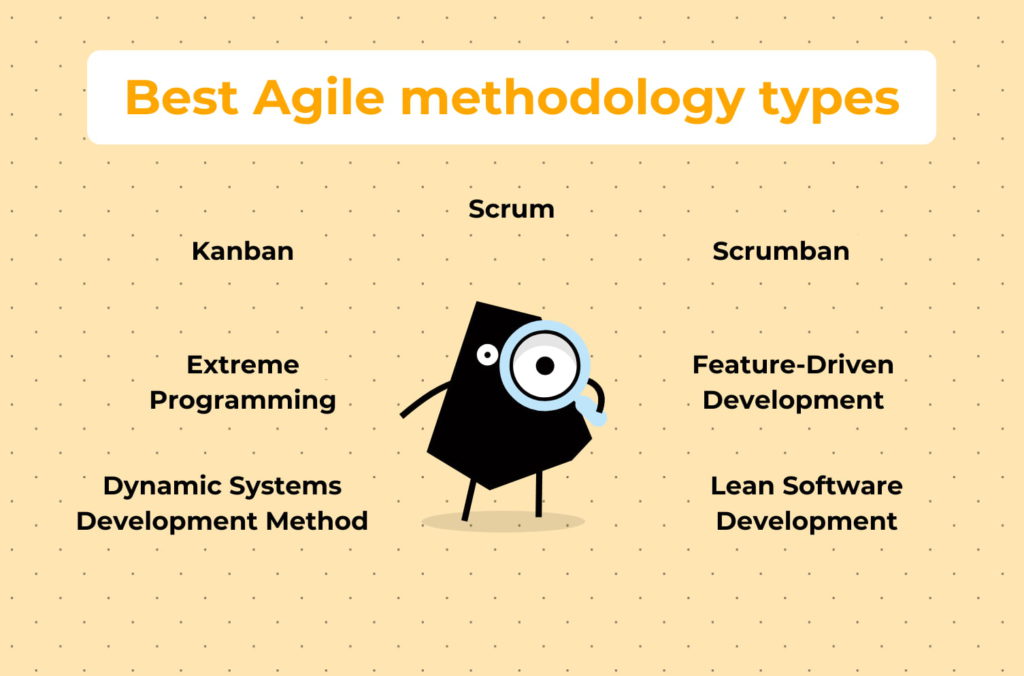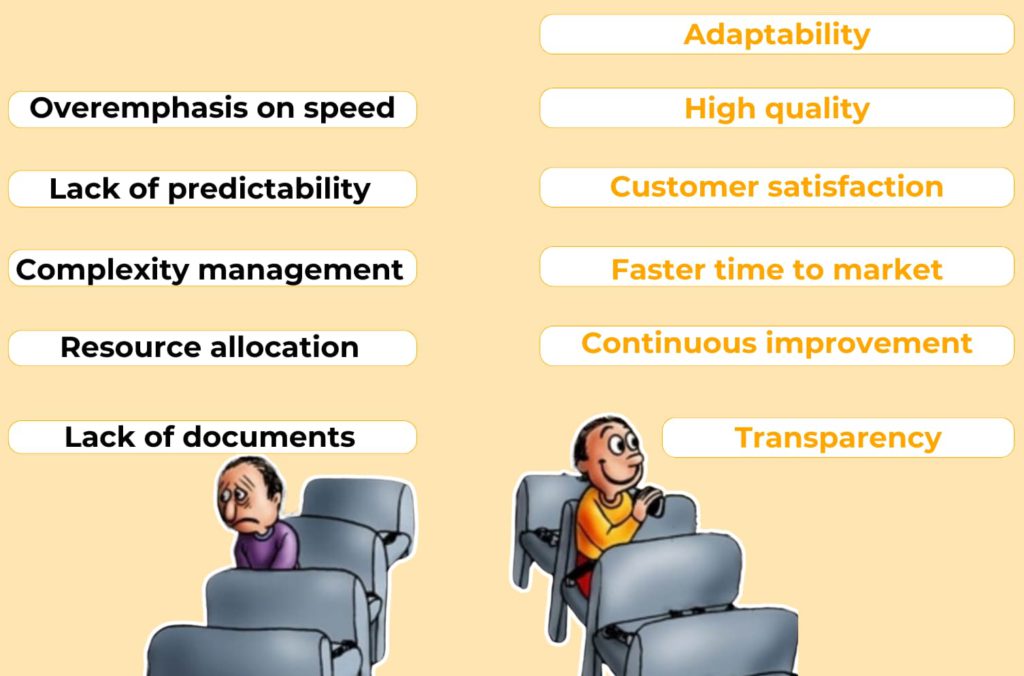Agile methodology pros and cons for software development

Have you ever felt a burden when realizing the scope of work that needs to be done? The agile methodology was made to avoid a feeling like that. By breaking tasks into smaller pieces, you and your team can focus on what matters most, collaborate closely, and continuously improve.
Agile methodology is applied in various industries, but it’s particularly prevalent and impactful in software development. So, whether you are building an MVP for an IT healthcare project or a fintech application, outsourcing data analytics or cloud development, running research and development, or any other project, agile methodology is most likely to be chosen.
Some interesting figures: According to the report, the Agile adoption is as follows: 86% software development, 63% IT, 29% Operations, 17% Marketing, 17% Security, 16% HR, 11% Sales/Sales ops, 10% Finance, 10% Hardware development.
Speaking of numbers, Agile’s success rate is 80% compared to Waterfall’s 24%, which is far from Agile. That’s why we discuss exactly Agile, the most efficient methodology wherever it is used especially in software development. Let’s learn more about the advantages and drawbacks of it.
Get rid of the software development burden with our Agile approach
What are the best types of Agile methodology for software development?
In a nutshell, agile methodology with its iterative and flexible approach to project management and software development prioritizes delivering working software incrementally in short iterations, known as sprints, rather than attempting to deliver the entire project at once. At this point, let’s consider Agile methodology types:

1. Scrum: Scrum is widely regarded as one of the best Agile methodologies for software development, particularly for teams working on projects with rapidly changing requirements and short development cycles.
It provides a structured framework for iterative development, with roles, ceremonies, and artifacts that facilitate collaboration and transparency. Scrum is well-suited to projects where frequent deliveries and continuous feedback are essential.
We, at GreenM, root for Scrum. We have Scrum-certified experts and stick mostly to this type.
2. Kanban: Kanban is an ideal Agile methodology for dev teams seeking to optimize workflow and visualize their work process. It is particularly suitable for projects with a steady flow of incoming tasks and a need for flexibility in prioritization. Kanban helps teams manage work in progress (WIP) and identify bottlenecks, leading to improved efficiency and faster delivery times.
3. Scrumban: It offers the best of both worlds, combining the structure and roles of Scrum with the flexibility and flow-based practices of Kanban. It is particularly suitable for teams seeking a smoother transition from Scrum to Kanban or looking to optimize their Agile practices based on their evolving needs and project dynamics.
4. Extreme Programming (XP): Extreme Programming is best suited for software development teams that prioritize engineering practices and high-quality code. XP practices refer to test-driven development (TDD), pair programming, continuous integration, and frequent releases. It is well-suited to projects where software quality and responsiveness to changing requirements are paramount.
5. Lean Software Development: Lean Software Development is ideal for delivering maximum value to customers while minimizing waste. Its principles refer to eliminating unnecessary work, amplifying learning, and delivering quickly. Lean is well-suited to projects where efficiency, speed, and customer satisfaction are critical success factors.
6. Feature-Driven Development (FDD): Feature-Driven Development is a good fit for large-scale projects with complex requirements. FDD is aimed at iterative and incremental development based on features or user stories.
It provides a structured approach to feature modeling, domain object modeling, and regular build and integration processes, making it suitable for projects with well-defined features and a need for disciplined development.
7. Dynamic Systems Development Method (DSDM): DSDM is best suited for projects with tight deadlines and a need for early delivery of business value. It provides a structured framework for Agile project management, with a focus on collaboration, iteration, and communication. DSDM is well-suited to projects where requirements are subject to change and delivering on time and within budget is critical.
What are Agile methodology pros and cons?
Based on the Agile methodology types given, it can be certainly stated that Agile software development principles, patterns and practices along with Secure Development Lifecycle (SDLC) and Continuous Integration/Continuous Delivery contribute a lot to software development. In this context, let’s speak about agile methodology strengths first.
Agile methodology advantages
Adaptability: Agile embraces change as a natural part of the development process. This flexibility allows teams to respond swiftly to shifting priorities, feedback, emerging requirements, or new market dynamics and make adjustments throughout the development process.
High quality: Through iterative development and frequent testing, Agile puts the accent on the importance of delivering high-quality software. By addressing issues early and often, a high standard of quality can be maintained throughout the development lifecycle.
Transparency: Agile methodologies promote transparency by making project progress, priorities, and impediments visible to all stakeholders. This fosters trust, collaboration, and alignment among team members and stakeholders.
Faster time to market: Agile’s iterative approach can deliver working software in short, frequent iterations or sprints. This allows for earlier delivery of valuable features and quicker time to market compared to traditional waterfall methods.
Continuous improvement: Agile promotes a culture of continuous improvement through regular reflection, feedback, and adaptation. By regularly reviewing and adjusting processes, teams can optimize their efficiency and effectiveness over time.
Customer satisfaction: Agile puts the customer at the forefront by continuously delivering increments of valuable software. This iterative approach ensures that the end product closely aligns with the customer’s vision and requirements.

Agile methodology drawbacks
Each thing has both strengths and weaknesses. The Agile is not an exception. Here are some nuances thereof:
Complexity management: While Agile excels in managing complexity within smaller teams or projects, it can become challenging to scale effectively in larger or more complex environments. Integrating Agile practices into larger organizational structures may pose difficulties.
Resource allocation: Agile requires active participation and commitment from team members, stakeholders, and customers throughout the development process. This engagement can sometimes strain resources, especially in organizations with competing priorities or limited availability.
Lack of predictability: Since Agile methodologies prioritize responding to change over following a plan, in the process, the customer may wish for extra or other features, which impacts project milestones and means project scope may change throughout the development process.
Lack of documents: Agile values working software over comprehensive documentation, which can pose challenges in environments where documentation is essential for compliance, regulatory, or knowledge management purposes.
Overemphasis on speed: Agile methodologies emphasize delivering working software quickly, which may lead to a focus on speed at the expense of other factors such as sustainability or long-term planning.
Agile software development companies show higher performance
Some other interesting figures: According to McKinsey and Co. research, 93% of Agile companies reported increased customer satisfaction, 76% enhanced employee engagement, and 93% better operational performance.
To sum up, the benefits Agile software companies have outweigh the challenges they face. Here, let’s take a deeper look at the way Agile organizations reach these results and how the process is made.
Agile software development team structure
Usually represented by a cross-functional team, the workflow of an Agile software development team involves:
Product owner: The product owner is responsible for representing the interests of the stakeholders and ensuring that the team delivers maximum value to the customer. They define the product vision, prioritize the backlog, and make decisions about what features should be built next.
Scrum Master: The Scrum Master serves as a servant-leader for the team, facilitating Scrum events, removing impediments, and fostering an environment conducive to collaboration and continuous improvement.
Development team: The dev team is cross-functional and typically includes software developers, testers, designers, and any other specialists necessary to complete the work.
UX/UI designers: UX/UI Designers are responsible for creating user interfaces and experiences that are intuitive, user-friendly, and visually appealing.
Quality assurance (QA) Engineers: QA Engineers are responsible for ensuring the quality of the software product through testing and validation.
Technical leads/architects: Technical Leads or Architects provide technical leadership and guidance to the Development Team.
DevOps engineers: DevOps Engineers are responsible for automating and streamlining the software development and deployment process.
Other supporting roles: Depending on the project’s complexity and requirements, Agile teams may include other supporting roles such as project managers, business analysts, data analysts, and technical writers to facilitate coordination and documentation.
Popular tools used in agile software development
Jira: Jira is one of the most widely used project management tools for Agile teams. It offers features such as sprint planning, backlog management, task tracking, and issue tracking. It allows teams to create user stories, assign tasks, track progress, and visualize project metrics through customizable dashboards and reports.
Trello: Trello is a flexible and intuitive project management tool based on the Kanban methodology. It uses boards, lists, and cards to visualize tasks and workflows, making it easy for teams to track progress, prioritize work, and collaborate in real time. Trello is particularly popular for its simplicity and ease of use.
Azure DevOps: Azure DevOps is a comprehensive suite of tools for Agile software development, including version control, continuous integration, release management, and Agile planning. It provides features such as backlog management, sprint planning, code repositories, build pipelines, and deployment automation, all integrated into a single platform.
GitLab: GitLab is a web-based Git repository manager that offers a complete DevOps platform for software development lifecycle management. It provides version control, issue tracking, code review, continuous integration, and deployment automation capabilities, allowing teams to collaborate effectively and deliver high-quality software.
GitHub: GitHub is a popular code hosting platform based on Git version control. It provides features such as code repositories, pull requests, issue tracking, project boards, and code review tools. GitHub fosters collaboration among developers and enables distributed teams to work together seamlessly on open-source and private projects.
Confluence: Confluence is a collaboration and documentation tool that allows teams to create, share, and collaborate on project documentation, requirements, meeting notes, and knowledge bases. It integrates with Jira and other Atlassian products to provide a centralized platform for capturing and sharing information across the organization.
Rally: Rally is an Agile project management tool that provides features such as backlog management, release planning, sprint planning, and progress tracking. It offers visibility into project status, dependencies, and impediments, helping teams to prioritize work and deliver value iteratively.
Agile software development consulting
Whether it’s about Agile software development in healthcare, ad tech, or other industries, consulting can help tailor Agile principles to specific business needs and ensure successful implementation and adoption. Consulting services offer valuable insights, best practices, and support throughout the Agile transformation journey.
Conclusion: use the Agile software development services without hesitation
Overall, the Agile software development adoption and implementation will work for you. In short, one more time again, it:
- puts the customer’s needs at the forefront,
- enhances management of changing priorities,
- accelerates software delivery,
- improves product quality,
- contributes to project visibility, and
- responds better to dynamic market conditions.
We, at GreenM, work with each tool, and technology stack, and have all in-house certified experts required to get the most out of the Agile methodology for software development, analytics, and other purposes.





